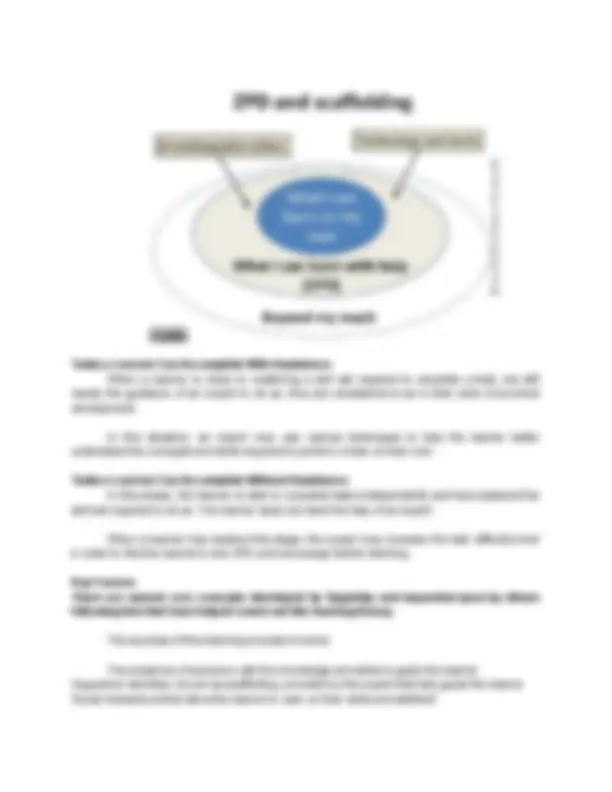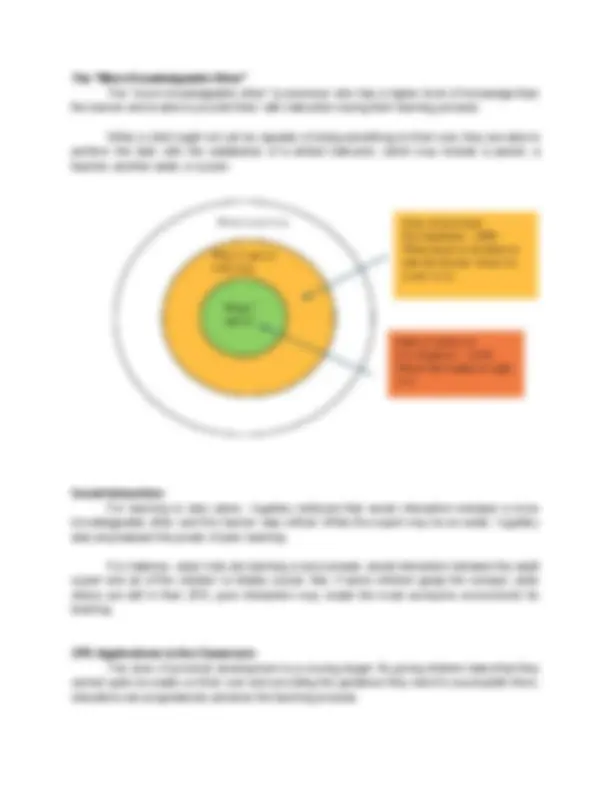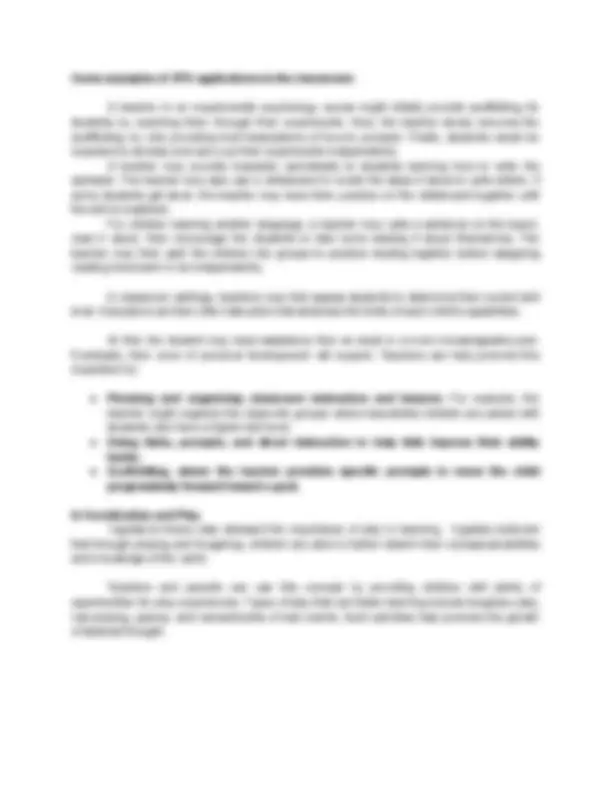






Study with the several resources on Docsity

Earn points by helping other students or get them with a premium plan


Prepare for your exams
Study with the several resources on Docsity

Earn points to download
Earn points by helping other students or get them with a premium plan
Community
Ask the community for help and clear up your study doubts
Discover the best universities in your country according to Docsity users
Free resources
Download our free guides on studying techniques, anxiety management strategies, and thesis advice from Docsity tutors
It can help you study about sociocultural psychology.
Typology: Papers
1 / 8

This page cannot be seen from the preview
Don't miss anything!





University of Eastern Pangasinan College of Teacher Education First semester AY 2022- PS1 : The Child and Adolescent Learner I. Objectives: At the end of the lesson, the students should be able to: a. explain sociocultural theory b. define ZPD c. explain the concept of ZPD d. characterize the stages of ZPD e. enumerate classroom applications of Sociocultural theory Lev Vygotsky’s Sociocultural Theory Vygotsky's sociocultural theory views human development as a socially mediated process in which children acquire their cultural values, beliefs, and problem-solving strategies through collaborative dialogues with more knowledgeable members of society. Vygotsky's theory is composed of concepts such as culture-specific tools, private speech, and the Zone of Proximal Development. Vygotsky's theories stress the fundamental role of social interaction in the development of cognition (Vygotsky, 1978), as he believed strongly that community plays a central role in the process of "making meaning." Unlike Piaget's notion that childrens' development must necessarily precede their learning, Vygotsky argued, "learning is a necessary and universal aspect of the process of developing culturally organized, specifically human psychological function" (1978, p. 90). In other words, social learning tends to precede (i.e., come before) development. What is Sociocultural Theory? Sociocultural theory stresses the role that social interaction plays in psychological development. It suggests that human learning is largely a social process, and that our cognitive functions are formed based on our interactions with those around us who are "more skilled." According to the sociocultural perspective, our psychological growth is guided, in part, by people in our lives who are in mentor-type roles, such as teachers and parents. Other times, we develop our values and beliefs through our interactions within social groups or by participating in cultural events. Sociocultural theory focuses on how mentors and peers influence individual learning, but also on how cultural beliefs and attitudes affect how learning takes place.
History of Sociocultural Theory Lev Vygotsky, believed that parents, caregivers, peers, and the culture at large are responsible for developing higher-order functions. According to Vygotsky, learning has its basis in interacting with other people. Once this has occurred, the information is then integrated on the individual level. Vygotsky contended that children are born with basic biological constraints on their minds. Each culture, however, provides "tools of intellectual adaptation." These tools allow children to use their abilities in a way that is adaptive to the culture in which they live. For example, one culture might emphasize memory strategies such as note-taking. Another might use tools like reminders or rote memorization (a technique that uses repetition). These nuances influence how a child learns, providing the "tools" that are appropriate to their culture. Vygotsky, born in 1896, was a contemporary of other great thinkers such as Freud, Skinner, and Piaget, but his early death at age 37 and the suppression of his work in Stalinist Russia initially left his theories less well-known. As his work has become more widely published, his ideas have grown increasingly influential in areas including child development, cognitive psychology, and education. What Is the Zone of Proximal Development? The zone of proximal development (ZPD), or zone of potential development, refers to the range of abilities an individual can perform with the guidance of an expert, but cannot yet perform on their own. Developed by psychologist Lev Vygotsky, this learning theory may be observed in a classroom setting or anywhere else where an individual has the opportunity to develop new skills. Stages of ZPD There are three distinct categories where a learner may fall in terms of their skill set. For learning to take place, it's critical that the expert understands the learner's specific ZPD stage. Task a Learner Cannot Accomplish With Assistance Tasks that are outside of the learner's ZPD are those that are unable to be completed even with the help of an expert. If the task isn't within the learner's ZPD, the expert may look to decrease the level of difficulty and find tasks that are more appropriate given the learner's skill level.
The "More Knowledgeable Other" The "more knowledgeable other" is someone who has a higher level of knowledge than the learner and is able to provide them with instruction during their learning process. While a child might not yet be capable of doing something on their own, they are able to perform the task with the assistance of a skilled instructor, which may include a parent, a teacher, another adult, or a peer. Social Interaction For learning to take place, Vygotsky believed that social interaction between a more knowledgeable other and the learner was critical. While the expert may be an adult, Vygotsky also emphasized the power of peer learning. For instance, when kids are learning a new concept, social interaction between the adult expert and all of the children is initially crucial. But, if some children grasp the concept, while others are still in their ZPD, peer interaction may create the most conducive environment for learning ZPD Applications in the Classroom The zone of proximal development is a moving target. By giving children tasks that they cannot quite do easily on their own and providing the guidance they need to accomplish them, educators can progressively advance the learning process.
Some examples of ZPD applications in the classroom: A teacher in an experimental psychology course might initially provide scaffolding for students by coaching them through their experiments. Next, the teacher slowly removes the scaffolding by only providing brief descriptions of how to proceed. Finally, students would be expected to develop and carry out their experiments independently. A teacher may provide traceable worksheets to students learning how to write the alphabet. The teacher may also use a whiteboard to model the steps it takes to write letters. If some students get stuck, the teacher may have them practice on the whiteboard together until the skill is mastered. For children learning another language, a teacher may write a sentence on the board, read it aloud, then encourage the students to take turns reading it aloud themselves. The teacher may then split the children into groups to practice reading together before assigning reading homework to do independently. In classroom settings, teachers may first assess students to determine their current skill level. Educators can then offer instruction that stretches the limits of each child's capabilities. At first, the student may need assistance from an adult or a more knowledgeable peer. Eventually, their zone of proximal development will expand. Teachers can help promote this expansion by: ● Planning and organizing classroom instruction and lessons. For example, the teacher might organize the class into groups where less-skilled children are paired with students who have a higher skill level. ● Using hints, prompts, and direct instruction to help kids improve their ability levels. ● Scaffolding, where the teacher provides specific prompts to move the child progressively forward toward a goal. In Socialization and Play Vygotsky's theory also stressed the importance of play in learning. Vygotsky believed that through playing and imagining, children are able to further stretch their conceptual abilities and knowledge of the world. Teachers and parents can use this concept by providing children with plenty of opportunities for play experiences. Types of play that can foster learning include imaginary play, role-playing, games, and reenactments of real events. Such activities help promote the growth of abstract thought.
How Vygotsky Impacts Learning Many psychologists, including Piaget and Bandura, have assessed the cultural influences on learning, however, only Vygotsky claims that they are inherently woven together. He felt that studies should be analyzing the individual within the society and not the individual itself. Only then could you observe the level of growth, as it is social interaction itself that promotes mental development. While morals, values, and thoughts are believed to be influenced by society, the process of learning is not seen as something that is mimicked. Vygotsky outlined that interactions with others created growth by making connections between concepts. To summarize, Vygotsky’s views on cognitive development can be grouped into four main points, outlined as follows: ● the relationship between the student and the teacher is central to learning; ● society and culture influence the attitudes and beliefs of a student towards learning and education; ● language is the primary tool used in the development of learning in children, including the transfer of sociocultural influences; and ● students benefit greatly in programs that are student-led, as they can use the social interaction to grow towards their potential level of development. Curriculum – Learning goals and curriculum outlines should be designed around social interaction between students and tasks. Instruction – The idea of scaffolding is the basis of instruction. Students can achieve their learning potential with guided instruction from their teacher. The teacher constantly reassesses the levels of achievement of the student and creates the next task as a building block to the goal. As an added benefit, the student also learns problem-solving skills from performing leveled tasks on their own. Assessment – Evaluations are catered to each student based on their zone of proximal development. As teachers strive to see the potential level of cognitive development in all students, assessments must cover a range of abilities. Some students may achieve a higher level with support from their teacher than others. Vygotsky vs. Piaget: Key Differences Jean Piaget was a psychologist and genetic epistemologist known for his theory of cognitive development which outlines the four stages in which children learn. Since they are both theories of learning, Vygotsky's theory is often compared to Piaget's. Vygotsky's Theory ● Social factors influence development ● Development can differ between cultures
Piaget's Theory ● Childhood interactions and explorations influence development ● Development is largely universal How does Vygotsky's sociocultural theory differ from Piaget's theory of cognitive development? Some suggest that these two theories of human development differ greatly due to their founders' different upbringings and that Vygotsky had strong cultural ties while Piaget had a lonely childhood. References: https://www.verywellmind.com/what-is-the-zone-of-proximal-development- https://www.verywellmind.com/what-is-sociocultural-theory-2795088#toc-applying-vygots kys-theory https://www.simplypsychology.org/vygotsky.html https://educationaltechnology.net/vygotskys-zone-of-proximal-development-and-scaffoldi ng/